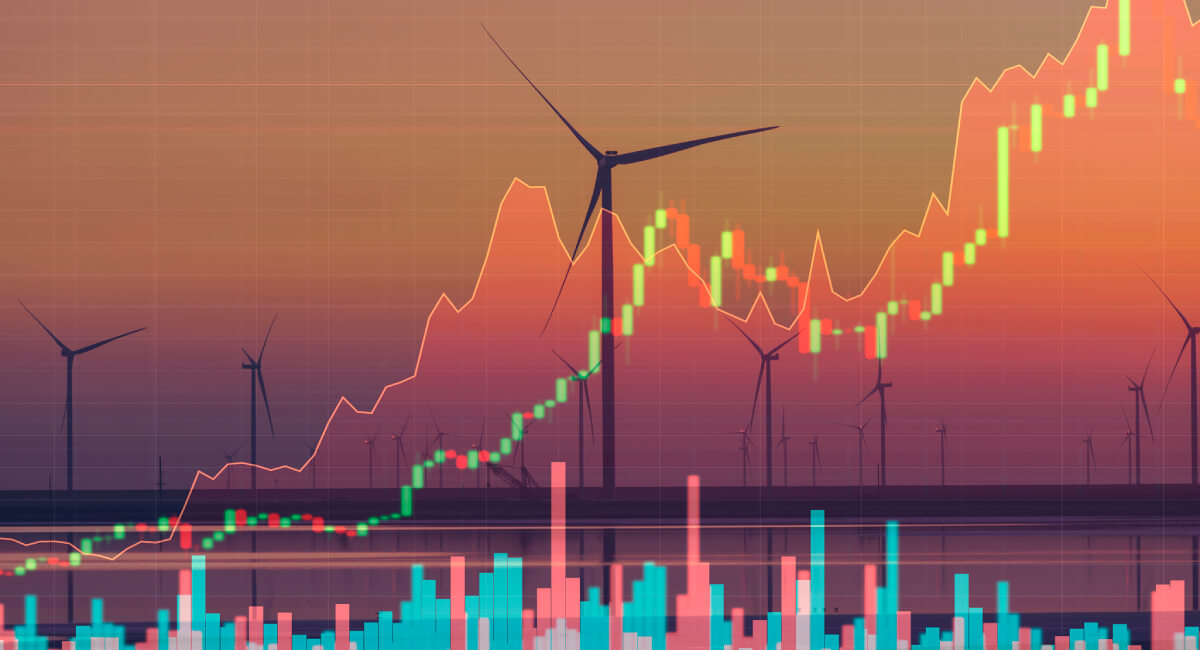Tackling the shift to renewable energy trading
Note: This article was originally published in New Energy World.
Increasing adoption of intermittent renewable energy sources like wind and solar is causing a shift in the electricity supply market. Franziska Danz, Vice President Product Management, ION Commodities, examines the implications for energy traders.
The energy trading picture is changing significantly as adoption of intermittent renewable energy sources increases. According to the International Energy Agency (IEA), global renewable energy capacity additions will see the largest recorded increase in 2023, soaring by 107 GW to 440 GW.
This shift is driven by numerous factors, including global policy support and political incentives, energy security concerns, and the increasing economic attractiveness of renewable energy production. Overall, cumulative world renewable capacity is forecast to reach over 4,500 GW at the end of 2024, equal to the combined power capacity of China and the US.
This growth of renewable power is leading to a decline in energy prices in the long term, largely driven by pricing dynamics in wholesale power markets.
Firms with long positions in regions that are becoming more reliant on renewable energy face double risks – decline in the value of their portfolio and rising volatility, compelling them to adapt both their asset strategies and trading operations.
Impact on wholesale power markets
Wind and solar energy are renewable sources of electricity that differ from traditional fossil fuel-based sources in two fundamental ways:
- Variable operating costs: Wind and solar energy have ‘more or less’ zero variable operating costs associated with generating an additional kilowatt-hour of energy. There are no fuel costs and ‘incremental’ maintenance costs are relatively low.
- Intermittency: The output of wind and solar energy is intermittent, depending on the quantity and quality of the solar or wind resource at any time. While this resource is predictable in the immediate future (that is, a few minutes in advance), and fairly predictable across large and diversified sample sizes on average, generating electricity from wind and solar can be hard to determine accurately.
The increasing adoption of renewable energy sources is leading to a shift in the electricity supply market, with coal and nuclear power losing market share. According to EnAppSys, power from renewable sources produced over 50% of Europe’s electricity output for the first time in 2Q2023, marking a 12% increase from the renewables’ energy share in 2017. Furthermore, wholesale power markets, where renewable energy is making significant penetration, are behaving very differently than in the past, with power generation in Europe dropping to a historic low of 596 TWh.
Because of the large quantities of near-zero variable-cost renewable supplies at many hours of the day, energy prices have been falling in many markets worldwide. Across Europe, these reductions translated into wholesale electricity prices dropping by approximately 15% in Spain, 25% in the UK, 35% in Italy, 38% in the Netherlands, 39% in France, 41% in Germany and 42% in Denmark on a quarter-over-quarter basis, according to the IEA.
Indeed, a profile of German wholesale power markets in Clean Energy Wire, noted that energy prices frequently become negative (below zero) due to the higher share of intermittent energy, as renewables generate in excess of what the grid can easily absorb.
On the other hand, when renewable energy supplies don’t ‘show up’ as expected due to unforeseen weather, real-time energy markets can struggle to clear. If this occurs at times of peak demand, such as a severe cold snap during winter or a heatwave during summer, energy prices can spike to extreme levels. With climate change impacting global weather patterns, these moments of extreme variability are becoming more common, though often hard to predict. These effects can be especially pronounced in localized power markets that are subject to transmission constraints, and often can’t be solved quickly by investments to expand inter-regional energy transfer capability.
Where they have existed historically, transmission constraints are likely to occur more frequently, and new constraints emerge – as large swaths of renewable energy are added in locations with favorable resources, and fossil plants retire in the face of declines in energy prices. As transmission constraints occur more often – with surpluses of renewable energy that cannot be exported or in regional deficits that cannot be alleviated by imports – deviations in power prices in neighboring markets will increase in frequency and magnitude.
Faced with lower average energy prices and higher peak prices, energy markets will experience increased levels of spot volatility as the share of renewable energy supply increases. As a consequence, the valuation of capacity markets will become more uncertain. Ancillary services pricing will also increase, because of the reduced certainty and more extreme price swings at any moment in time as the electricity market tries to balance.
Wholesale power markets
The changes brought by the increasing penetration of renewables on wholesale markets are a mixed blessing. On the positive side, greater pricing volatility creates more opportunities for traders. For example, as localized markets become more divergent with the increasing frequency of transmission constraints, widening basis differentials will create new arbitrage opportunities and corresponding trades to execute.
Any increase in potential rewards is correlated with greater risk exposure. In the case of wholesale energy markets, with substantial renewable energy penetration, the risks are highly nonlinear and more difficult to translate to trading strategies, market-to-market analyses, and value-at-risk calculations.
Power operators are required to balance the demand and supply of their assets, but it is difficult to forecast renewable energy such as wind and solar due to their intermittent weather patterns. While day-ahead trading traditionally served as the primary market mechanism for spot power trading, the gap between the day-ahead phase and the actual production of power can be susceptible to weather shifts that impact the output of renewable energy. Therefore, traders are witnessing a shift in focus to the very short term.
Companies are increasingly deploying intraday trading, meaning their positions can be traded minutes before delivery. Discrepancies between power production and consumption are subject to imbalance prices, so that the ability to adjust a trading position quickly is key to maximize profit and stability.
Moreover, because renewable energy assets are not dispatchable, there are fewer degrees of ‘optionality’ for traders to exploit. On the other hand, as dispatchable generation assets (that is, sources of electricity that can be programmed on demand at the request of power grid operators) play a smaller role in the overall supply base, their intrinsic optionality will become increasingly valuable. However, they may be more complicated to capture, as these power plants play a shrinking role for grid operators.
There is exponential growth in battery storage, particularly those installations that are co-located with renewable assets. The UK’s battery storage market leads its European counterparts and is expected to reach 24 GW capacity by the end of the decade, according to Rystad Energy.
To cope with this greater degree of market complexity, trading and hedging operations will need to invest in better real-time asset forecasting capabilities and perform more frequent refreshes of analytics and accounting incorporating more up-to-date information, with tighter integration between asset operations, trading desks, and back-offices.
Renewable energy trading will be the next era of power trading and requires major upgrades in systems responsible for data collection, processing, and reporting.
Wider implications
The energy transition is gaining momentum, marking a significant departure from the historical dependence on fossil fuels and nuclear power. According to EnAppSys, the balance between clean energy expenditures and investments in fossil fuels has experienced a noteworthy shift, with $1.7 invested in clean energy for every $1 in fossil fuels today, up from a 1:1 ratio five years ago.
However, unlocking the full potential of this investment requires collaboration between governments and industry-wide stakeholders, potentially supported through subsidies, tax breaks, and grants.
While many are broadly supportive of the transition to renewable energy, there is also disagreement by a significant portion of the population here and abroad with reservations about installation of the necessary infrastructure.
The US and Canada, for example, possess exceptional potential to generate renewable energy, due to the strong winds and abundant sunlight in their vast plains and coastal regions. Nevertheless, to capitalize on these resources will require extensive high-voltage transmission lines, given their often remote location from towns and other existing infrastructure.
As the pursuit of a 100% renewable energy system gains traction, the variability of renewable energy assets demands strategies to manage output variability and backup during low wind and solar periods, possibly involving fossil fuel-based solutions in the short term.
Experts propose a multifaceted approach, including energy source diversification and cross-government cooperation to counter renewable fluctuations intensified by extreme weather events. Using batteries in grid-scale energy storage systems as an emergency reserve can balance power generation and ensure grid stability in the short term.
Furthermore, imbalance costs that arise from unpredictable weather must also be mitigated with investments in better forecasting software. Companies operating within the renewable energy sector are likely to perform best by leveraging technology to automate the gathering, interpretation, and deployment of accurate forecasting data.
The rising adoption and investment into intermittent renewable energy sources is revolutionizing the power sector and reshaping market dynamics as traditional coal and nuclear power recede. The anticipated surge in renewable energy capacity and the consequential impact on energy prices highlights the imperative for adaptable trading approaches within the evolving wholesale power markets. As these changes unfold, the industry is presented with both challenges and opportunities, underscoring the need to modernize trading systems to navigate this market landscape effectively.

